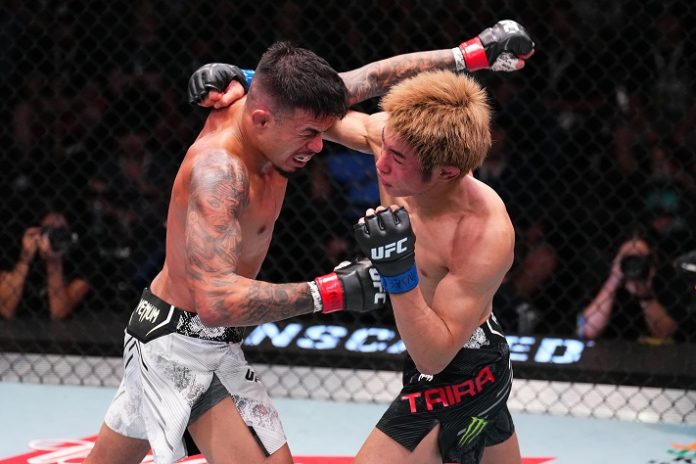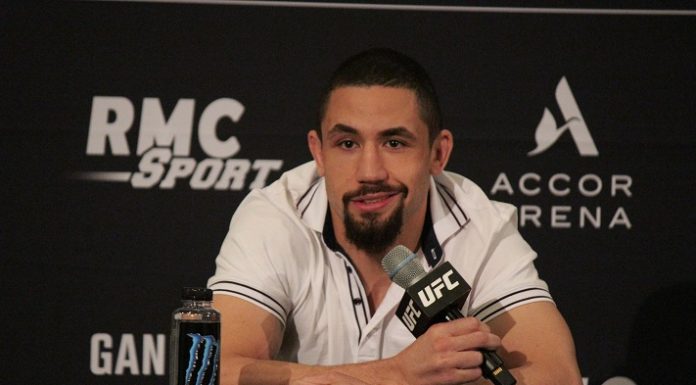
MMA is a roller coaster. Fighters know that, fans know that, and the media covering the sport most certainly does as well.
The highs are high, the lows are low, and the burnout is real. Yet there are moments that draw you back to the sport, that make it inimitably watchable, a sport like no other. That leave you to exclaim, Al Pacino in The Godfather Part III style, “just when I thought I was out, they pull me back in.”
The rise and fall and recovery of the UFC’s flyweight division isn’t exactly a “moment,” but it has certainly produced enough to them. This past weekend, UFC Vegas 98 was a reminder that the once-maligned 125lb division is one of the most entertaining in the sport. It’s jaw-dropping to think that once, UFC President and CEO Dana White considered giving the division the axe.
That was in 2018, the same year future ONE Championship star Jarred “The Monkey God” Brooks was released by the UFC… off a win. Brooks wasn’t the only fighter shown the door; Dustin Ortiz fought out his deal in January 2019, after being offered his release outright. After being formed in 2012 and producing one of the most dominant UFC champions in company history, Demetrious “Mighty Mouse” Johnson, the weight class was rumored to be phased out as early as November 2018.
The reasoning? The flyweights “didn’t draw.” They “lacked excitement.” The usual gang of idiots (no, not the fine folks at Mad Magazine) complained that they were too small, much as that same crowd complained when featherweights and bantamweights entered the UFC, not to mention women.
Of course, when you don’t put effort into promoting something, which is a promotor’s job (it’s literally in the name, after all), that’s an easily anticipated result. The flyweights didn’t draw, because outside of some lip service to Johnson’s accolades, the UFC didn’t promote them. Remember the time Mighty Mouse couldn’t even get all the championship belts he’d earned, after Daniel Cormier showed off his own bling collection?
To their credit, Dana White and crew reversed course on the decision to cut flyweight. White would later credit UFC matchmaker Mick Maynard with rebuilding the weight class, though in reality, the bulk of the credit goes to the fighters. Deiveson Figueiredo stepped up and became a bonafide star; Brandon Moreno returned from his own brief release and entered a rivalry with the “God of War” that produced not a trilogy but a full four-fight rivalry. That meant “Figgy” faced off with Moreno on four consecutive occasions (for Moreno, there was a fight with Kai-Kara France mixed between his final two bouts with Figueiredo).
Two fighters does not make a full recovery, however, but names like Alexandre Pantoja, Kai Kara-France, Brandon Royval, and others helped prove that there was excitement to be found in the UFC’s smallest weight class.
And then Tatsuro Taira, an undefeated Japanese prospect, arrived. This past Saturday at UFC Vegas 98, he was dealt his first setback by the aforementioned Royval. Yet the five-round affair proved to be an instant flyweight classic, a back-and-forth struggle and clash of styles that is exactly what you look for in high level MMA. Saturday’s flyweight fun didn’t stop there: earlier in the night, Ramazan Temirov made a spectacular debut, with the Uzbek prospect smashing CJ Vergara and announcing plans for his own title run.
Add incoming RIZIN star Kai Asakura to the mix (the UFC just granted him an immediate title shot in his promotional debut), and you have to wonder how the UFC ever considered cutting flyweight at all. Building something seems far more optimal than just throwing it away, after all. Yes, it takes a little effort, but for a company with a marketing machine like no other, it’s almost a no-brainer.
The comparison to the now-defunct women’s featherweight division is obvious. Imagine, if you will, had the UFC opted to go the same route with that 145lb weight class as they did with flyweight. Once upon a time, the UFC had both Cris Cryborg and then double-champ Amanda Nunes locked under contract. They let one slip away, while the other retired. Fast forward to 2024, and Cyborg remains active in other promotions, while ex-PFL star Kayla Harrison is under the UFC banner, starving herself down to 135. Nunes continues to tease her return. The UFC might have had all three, and Larissa Pacheco (who had a brief UFC run) to boot.
The UFC made the right call in keeping flyweight around. Instead of gripes about flyweight being boring, fans were clear after UFC Vegas 98: they want more flyweight main events. Preferably in front of a full house, rather than tucked away at the UFC Apex. Luckily, one of those arrives in Edmonton early next month, when Brandon Moreno meets Amir Albazi.
Baby steps, but in the right direction. And the recovery of the UFC’s smallest weight class has been nothing short of remarkable. Proving that flyweight’s got fight.





















